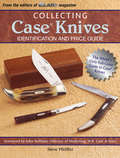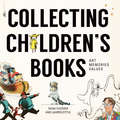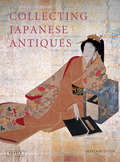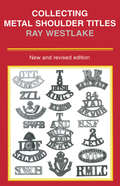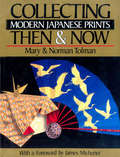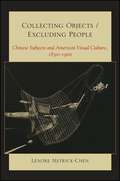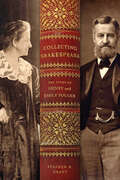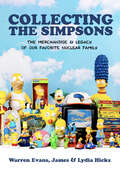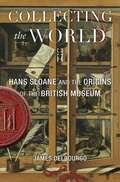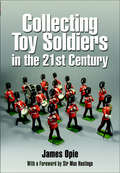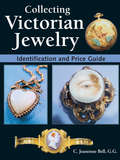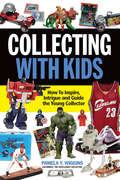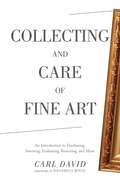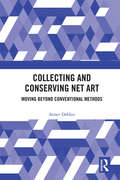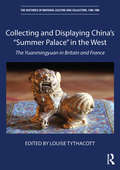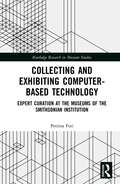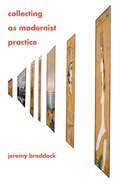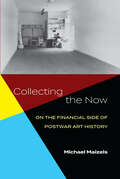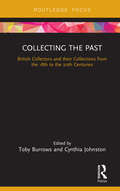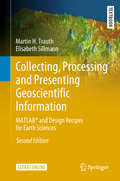- Table View
- List View
Collecting Autographs
by Susan BrewerWritten by collectables expert Susan Brewer, the book covers the world of autographs, both beautifully-illustrated autograph books from the days when ordinary people signed them for friends with thoughtful poems or illustrations, to celebrity and highly collectable autographs. Hundreds of verses and reflective messages are included, as well as many humorous entries gleaned from autograph albums over the years.The book begins with a general overview of autographs, autograph collecting and autograph books, has a chapter on preserving and storing autographs, advice on how to collect them and ends with a directory of auction houses which specialise in ephemera. Examples of autographs include Victorian politicians, Prime Ministers, royalty, artists, actors, sportsmen and ordinary people who took the time to think up clever rhymes or stunning illustrations. Aimed at the collectable market but also nostalgia as so many people used to collect autographs at stage doors or end of pier shows. This book will appeal not only to the collector but to anyone interested in social history and our changing way of life.
Collecting Case Knives: Identification and Price Guide
by Steve PfeifferFeast your eyes on the craftsmanship and quality that is synonymous with Case pocket knives with this one-of-a-kind guide. The only full-color book focused solely on the work of W.R. Case & Sons Cutlery Co., this book delves into Cases 120-year history and provides you with the defining details for hundreds upon hundreds of knives. In this historically rich guide, you'll discover 800 full-color photos, current values for hundreds of pocket knives considered the most popular among collector, and a potpourri of information about methods for creating knives, quirks of the pattern numbering systems, tang samplings, types of blade steels and knife shields, as well as: Identifying and pricing details for prized knives including Pattern 20 Peanut, highly popular 54 Pattern Trapper, Pattern 72 Bulldog and Buffalo, and Pattern 97 Shark Tooth A showcase of the different types of natural and synthetic handle materials used to create Case knives, including bone, stag, pearl...wood, family and colorful celluloid, plastic and metal Whether you received your Case knife as a gift, inherited if from a family member or simply chose to purchase your own, you will enjoy the depth of details, exquisite photographs, and intriguing historical information contained in this, the only full-color book devoted to the legendary W.R. Case & Sons Cutlery Co.
Collecting Children's Books: Art, Memories, Values
by Noah Fleisher Lauren ZittleWhen We Were Very YoungChildren's Books delight the young and the young at heart. From the gentle ritual of Goodnight Moon to the incredible odyssey of bad boy Max in Where the Wild Things Are, these timeless tales remain with us as certainly as a mother's hug.Collecting Children's Books showcases some of the finest books and accompanying artwork from 1900 to the present in a warm, informative and exquisite fashion, reminding us all of the joy found in this transcendent genre. From Winnie-the-Pooh to Curious George, Alice in Wonderland to Mary Poppins, and from The Poky Little Puppy to The Very Hungry Caterpillar, you will enjoy a treasure trove of remarkable--and highly collectible--children's literature.This delightful hardcover book features:More than 100 years of classic and collectible Children Books, including values for signed and unsigned First Edition works.500 color imagesOriginal art from such masters as Garth Williams (Charlotte's Web, Stuart Little), Maurice Sendak (Where the Wild Things Are) and Dr. Seuss.Collecting tips, what to look for when buying, and lists of suggested readings by era for those seeking to rediscover the pleasure--and value--found in children's literature.
Collecting Gadgets & Games from the 1950s–90s (Great British Collectable Toys Ser.)
by Daniel BlytheA nostalgic celebration of collectible treasures through the decades. Daniel Blythe takes a trip down memory lane with his first book for Remember When, focusing on toys, games, and gadgets from our youth; from Simon to the ZX Spectrum, from the Walkman to the boom box, from the Batmobile to James Bond’s Aston Martin and the TARDIS. From gadgets everyone had to those they desired to own, this is the book on big boys’ toys and their value. Whilst firms such as Sony focus on toys of the future, the latest Playstations and XBoxes, the author looks at the forgotten gadgets, the early MP3 players and radio sets and shows how to turn them into ready-money or future collectibles. He also reveals what makes a future collectible and discovers which action heroes are better than others when it comes to the collectibles world.
Collecting Japanese Antiques
by Alistair SetonCollecting Japanese Antiques shows what makes Japanese aesthetics so different from other countries. Antique hunters will benefit from the practical and cautionary advice in this book; newcomers will appreciate information on the basics of collecting; while other sections might reawaken interest in experienced collectors. Striking photographs highlight the beauty and craftsmanship of items such as solid wood chests and elegant prints and ceramics. A glossary explains antique-related Japanese terms.
Collecting Japanese Antiques
by Alistair SetonCollecting Japanese Antiques shows what makes Japanese aesthetics so different from other countries. Antique hunters will benefit from the practical and cautionary advice in this book; newcomers will appreciate information on the basics of collecting; while other sections might reawaken interest in experienced collectors. Striking photographs highlight the beauty and craftsmanship of items such as solid wood chests and elegant prints and ceramics. A glossary explains antique-related Japanese terms.
Collecting Japanese Antiques
by Alistair SetonCollecting Japanese Antiques shows what makes Japanese aesthetics so different from other countries. Antique hunters will benefit from the practical and cautionary advice in this book; newcomers will appreciate information on the basics of collecting; while other sections might reawaken interest in experienced collectors. Striking photographs highlight the beauty and craftsmanship of items such as solid wood chests and elegant prints and ceramics. A glossary explains antique-related Japanese terms.
Collecting Metal Shoulder Titles
by Ray WestlakeA revised and updated collector’s reference guide to British Army metal shoulder titles from all the various units.Newly revised and updated, Collecting Metal Shoulder Titles records the titles worn throughout the British Army by units of the Regular, Militia, Yeomanry, Volunteer, Territorial and Cadet forces.Details of some two thousand patterns are set out in the text and illustrated by photographs from the author’s unique collection.Ray Westlake is a recognised authority on British Army lineage and gives dates of formation, amalgamation, disbandment and changes in designation for all regiments.Collecting Metal Shoulder Titles is recognised by collectors and military historians alike as the definitive reference work.Today, some sixteen years after it first appeared, the book remains the only reliable guide to an increasingly popular form of collecting.This edition, with two supplements, brings it abreast of the last round of mergers and amalgamations.
Collecting Modern Japanese Prints
by James A. Michener Norman Tolman Mary TolmanThis book contains several bodies of information. An introductory essay puts Japanese prints into historical perspective and gives a brief outline of techniques. The second section, "Then," illustrated with prints by the older masters of the twentieth century, seeks to describe how we went about putting together our collection. There should not be many surprises here since these artists, many in their seventies, eighties, and nineties, will be known andeasily recognized by anyone who has even a minor interest in modern Japanese prints. These artists have been written about at great length elsewhere, though not perhaps from our unique viewpoint as collectors and dealers.The following section, "Between Then and Now," is a lengthy essay meant to be amusing. In this book about collecting, this essay gives a play-by-play description of a collector and his determined search for a specific print. It was not intended to be the ultimate in name-dropping, but was included to indicate the esteem and admiration that Japanese prints command abroad.The last section, "Now," using fifty artists with fifty illustrations to explain specific points about print collecting, gives not only objective facts about each artist and his work but also includes anecdotes that may help a collector better recognize and remember them. Some of these artists have already been briefly mentioned in the "Then" section. We wish to state that not all of the artists talked about are artists whom we handle in our gallery; we also hasten to point out that ail of the artists whom we do carry are, of course,included here. We have presented all of the prints in full color, in as large aformat as possible, so that the art lover can savor the details of each work.
Collecting Native America, 1870-1960
by Shepard KrechBetween the 1870s and 1950s collectors vigorously pursued the artifacts of Native American groups. Setting out to preserve what they thought was a vanishing culture, they amassed ethnographic and archaeological collections amounting to well over one million objects and founded museums throughout North America that were meant to educate the public about American Indian skills, practices, and beliefs.In Collecting Native America contributors examine the motivations, intentions, and actions of eleven collectors who devoted substantial parts of their lives and fortunes to acquiring American Indian objects and founding museums. They describe obsessive hobbyists such as George Heye, who, beginning with the purchase of a lice-ridden shirt, built a collection that--still unsurpassed in richness, diversity, and size--today forms the core of the Smithsonian's National Museum of the American Indian. Sheldon Jackson, a Presbyterian missionary in Alaska, collected and displayed artifacts as a means of converting Native peoples to Christianity. Clara Endicott Sears used sometimes invented displays and ceremonies at her Indian Museum near Boston to emphasize Native American spirituality. The contributors chart the collectors' diverse attitudes towards Native peoples, showing how their limited contact with American Indian groups resulted in museums that revealed more about assumptions of the wider society than about the cultures being described.
Collecting Objects / Excluding People: Chinese Subjects and American Visual Culture, 1830-1900
by Lenore Metrick-ChenIn Collecting Objects / Excluding People, Lenore Metrick-Chen demonstrates an unknown impact of Chinese immigration upon nineteenth-century American art and visual culture. The American ideas of "Chineseness" ranged from a negative portrayal to an admiring one and these varied images had an effect on museum art collections and advertising images. They brought new ideas into American art theory, anticipating twentieth-century Modernism. Metrick-Chen shows that efforts to construct a cultural democracy led to the creation of unforeseen new categories for visual objects and unanticipated social changes. Collecting Objects / Excluding People reveals the power of images upon culture, the influence of media representation upon the lives of Chinese immigrants, and the impact of political ideology upon the definition of art itself.
Collecting Shakespeare: The Story of Henry and Emily Folger
by Stephen H. GrantThe first biography of Henry and Emily Folger, who acquired the largest and finest collection of Shakespeare in the world.In Collecting Shakespeare, Stephen H. Grant recounts the American success story of Henry and Emily Folger of Brooklyn, a couple who were devoted to each other, in love with Shakespeare, and bitten by the collecting bug.Shortly after marrying in 1885, the Folgers started buying, cataloging, and storing all manner of items about Shakespeare and his era. Emily earned a master's degree in Shakespeare studies. The frugal couple worked passionately as a tight-knit team during the Gilded Age, financing their hobby with the fortune Henry earned as president of Standard Oil Company of New York, where he was a trusted associate of John D. Rockefeller Sr.While a number of American universities offered to house the collection, the Folgers wanted to give it to the American people. Afraid the price of antiquarian books would soar if their names were revealed, they secretly acquired prime real estate on Capitol Hill near the Library of Congress. They commissioned the design and construction of an elegant building with a reading room, public exhibition hall, and the Elizabethan Theatre. The Folger Shakespeare Library was dedicated on the Bard's birthday, April 23, 1932.The library houses 82 First Folios, 275,000 books, and 60,000 manuscripts. It welcomes more than 100,000 visitors a year and provides professors, scholars, graduate students, and researchers from around the world with access to the collections. It is also a vibrant center in Washington, D.C., for cultural programs, including theater, concerts, lectures, and poetry readings.The library provided Grant with unprecedented access to the primary sources within the Folger vault. He draws on interviews with surviving Folger relatives and visits to 35 related archives in the United States and in Britain to create a portrait of the remarkable couple who ensured that Shakespeare would have a beautiful home in America.
Collecting The Simpsons: The Merchandise & Legacy of Our Favorite Nuclear Family
by James Hicks Warren Evnas Lydia HicksThe Simpsons Merchandise Guide for all Simpsons Lovers “What are the two things every Simpsons’ collector needs? This book and shelves! “ ─Stephanie Gillis, Writer on The Simpsons#1 Best Seller in TV History & CriticismThis quirky book unleashes the entire story of all Simpsons merchandise, spanning decades. Lydia and James Hicks, authors of the bestselling The Simpsons Secret, partner with Warren Evans, the Bart of Darkness, to detail a massive collection of rare Simpsons memorabilia.Jump right into 90s nostalgia! Simpsons lovers everywhere, explore the explosion of Simpsons merchandise and products right in the comfort of your own home. From action figures, video games, comics, lunch boxes, and yes, even cookie jars, this book is a collector's paradise full of insightful information.The perfect collector’s item to have! This full-color guide features high quality photos of Simpsons-inspired products and is the perfect gift for Simpsons lovers as well as fans of Friends, Family Guy, and other classics!Inside:Read for fun: all of the words of Warren Evans, a note-worthy expert on The Simpsons familyFind full-colored photographs of Simpsons merchandise and collector items from the beginning of The Simpsons dynastyIf you're looking for one of the best books for TV nerds who like The Big Bang Theory, Welcome to Dunder Mifflin, or The Simpsons Secret, then Collecting the Simpsons belongs right on your bookshelf!
Collecting The World: Hans Sloane And The Origins Of The British Museum
by James DelbourgoIn 1759 the British Museum opened its doors to the general public--the first free national museum in the world. James Delbourgo's biography of Hans Sloane recounts the story behind its creation, told through the life of a figure with an insatiable ambition to pit universal knowledge against superstition and the means to realize his dream. Born in northern Ireland in 1660, Sloane amassed a fortune as a London society physician, becoming a member of the Whig establishment and president of the Royal Society and Royal College of Physicians. His wealth and contacts enabled him to assemble an encyclopedic collection of specimens and objects--the most famous cabinet of curiosities of its time. For Sloane, however, collecting a world of objects meant collecting a world of people, including slaves. His marriage to the heir of sugar plantations in Jamaica gave Sloane access to the experiences of planters and the folkways of their human property. With few curbs on his passion for collecting, he established a network of agents to supply artifacts from China, India, North America, the Caribbean, and beyond. Wampum beads, rare manuscripts, a shoe made from human skin--nothing was off limits to Sloane's imagination. This splendidly illustrated volume offers a new perspective on the entanglements of global scientific discovery with imperialism in the eighteenth century. The first biography of Sloane based on the full range of his writings and collections, Collecting the World tells the rich and complex story of one of the Enlightenment's most controversial luminaries.
Collecting Toy Soldiers in the 21st Century
by James Opie Sir Mark HastingsA completely updated edition of the classic guide, by a leading authority in the field: &“For the toy soldier collector, an absolute must have.&”—Miniature Wargames James Opie&’s highly popular Collecting Toy Soldiers was an inspiration for anyone involved in the hobby. Decades later, this is a completely new companion updating the experience for the twenty-first century collector. James now gives the reader the benefit of his long experience as one of the world&’s leading authorities on toy soldiers, figures, and models, and a lifetime as a passionate collector himself. Collecting Toy Soldiers in the 21st Century contains comprehensive advice on all aspects of collecting, fully illustrated with new pictures. Guidance for every budget includes price trends and pitfalls to avoid when buying or selling at auction, at shows, online, or privately. Sharing informative and often-amusing anecdotes, James illustrates just how satisfying it can be to explore this blend of history, tradition, nostalgia, and play, whether on the grandest scale or with the most limited of funds.
Collecting Victorian Jewelry: Identification and Price Guide
by Jeanenne BellQueen Victoria of Great Britain made a tremendous impact on the world, so much so that the era of her reign was given her name. Items from the Victorian period have a reputation for beauty and elegance, which is why they are such popular collectibles. This one-of-a-kind reference covers the beautiful jewelry of the Victorian Age, from 1837 to 1901. Gemologist C. Jeanenne Bell offers collectors this fascinating all-color exploration of the illustrious age and the elegant jewelry that is produced. Decade by decade, Bell reveals how the fashion of the time influenced the style of jewelry, and how innovations in manufacturing affected jewelry production. Jewelry listings provide current marketplace values, and also cover American and French jewelry styles from the time. Over 1,000 color pictures and illustrations convey the true beauty of Victorian era jewelry it produced.
Collecting With Kids: How To Inspire, Intrigue and Guide the Young Collector
by Pamela Y. WigginsHow To Inspire, Intrigue and Guide the Young Collector
Collecting and Care of Fine Art: An Introduction to Purchasing, Investing, Evaluating, Restoring, and More
by Carl David Richard J. BoyleFor novices and experienced collectors alike, Collecting and Care of Fine Art is a thorough examination of the intricacies of the art market. Written by a professional art dealer, this book covers all phases of buying, selling, and caring for works of art, from auctions and insurance to restorations and appraisals.Carl David’s advice to the layman is invaluable, covering such topics as the characteristics of a gallery and its proprietor that will assure forthright dealings; what deals to avoid; the criteria to be followed by the beginner about to make his first purchase; and precautions to take in the conservation of paintings, from simple cleaning to restoration techniques.For the art collector, indispensible information is provided, including details of shipping and insuring works of art, how to gauge the competence of an appraiser, the many elements that influence art prices, the tax benefits and liabilities of art investment, and much more.This book is a practical and wide-reaching guide that collectors and investors may turn to with confidence. In this updated edition, the author includes new and up-to-date chapters and information.
Collecting and Conserving Net Art: Moving beyond Conventional Methods
by Annet DekkerCollecting and Conserving Net Art explores the qualities and characteristics of net art and its influence on conservation practices. By addressing and answering some of the challenges facing net art and providing an exploration of its intersection with conservation, the book casts a new light on net art, conservation, curating and museum studies. Viewing net art as a process rather than as a fixed object, the book considers how this is influenced by and executed through other systems and users. Arguing that these processes and networks are imbued with ambiguity, the book suggests that this is strategically used to create suspense, obfuscate existing systems and disrupt power structures. The rapid obsolescence of hard and software, the existence of many net artworks within restricted platforms and the fact that artworks often act as assemblages that change or mutate, make net art a challenging case for conservation. Taking the performative and interpretive roles conservators play into account, the book demonstrates how practitioners can make more informed decisions when responding to, critically analysing or working with net art, particularly software-based processes. Collecting and Conserving Net Art is intended for researchers, academics and postgraduate students, especially those engaged in the study of museum studies, conservation and heritage studies, curatorial studies, digital art and art history. The book should also be interesting to professionals who are involved in the conservation and curation of digital arts, performance, media and software.
Collecting and Displaying China's “Summer Palace” in the West: The Yuanmingyuan in Britain and France (The Histories of Material Culture and Collecting, 1700-1950)
by Louise TythacottIn October 1860, at the culmination of the Second Opium War, British and French troops looted and destroyed one of the most important palace complexes in imperial China—the Yuanmingyuan. Known in the West as the "Summer Palace," this site consisted of thousands of buildings housing a vast art collection. It is estimated that over a million objects may have been taken from the palaces in the Yuanmingyuan—and many of these are now scattered around the world, in private collections and public museums. With contributions from leading specialists, this is the first book to focus on the collecting and display of "Summer Palace" material over the past 150 years in museums in Britain and France. It examines the way museums placed their own cultural, political and aesthetic concerns upon Yuanmingyuan material, and how displays—especially those at the Royal Engineers Museum in Kent, the National Museum of Scotland and the Musée Chinois at the Château of Fontainebleau—tell us more about European representations and images of China, than they do about the Yuanmingyuan itself.
Collecting and Exhibiting Computer-Based Technology: Expert Curation at the Museums of the Smithsonian Institution (Routledge Research in Museum Studies)
by Petrina FotiComputer technology has transformed modern society, yet curators wishing to reflect those changes face difficult challenges in terms of both collecting and exhibiting. Collecting and Exhibiting Computer-Based Technology examines how curators at the history and technology museums of the Smithsonian Institution have met these challenges. Focusing on the curatorial process, the book explores the ways in which curators at the institution have approached the accession and display of technological artifacts. Such collections often have comparatively few precedents, and can pose unique dilemmas. In analysing the Smithsonian’s approach, Foti takes in diverse collection case studies ranging from DNA analyzers to Herbie Hancock’s music synthesizers, from iPods to born-digital photographs, from the laptop used during the filming of the television program Sex and the City to "Stanley" the self-driving car. Using her proposed model of "expert curation", she synthesizes her findings into a more universal framework for undertanding the curatorial methods associated with computer technology and reflects on what it means to be a curator in a postdigital world. Collecting and Exhibiting Computer-Based Technology offers a detailed analysis of curatorial practice in a relatively new field that is set to grow exponentially. It will be useful reading for curators, scholars, and students alike.
Collecting as Modernist Practice (Hopkins Studies in Modernism)
by Jeremy BraddockWinner of the Modernist Studies Association Book Prize of the Modernist Studies AssociationIn this highly original study, Jeremy Braddock focuses on collective forms of modernist expression—the art collection, the anthology, and the archive—and their importance in the development of institutional and artistic culture in the United States.Using extensive archival research, Braddock's study synthetically examines the overlooked practices of major American art collectors and literary editors: Albert Barnes, Alain Locke, Duncan Phillips, Alfred Kreymborg, Amy Lowell, Ezra Pound, Katherine Dreier, and Carl Van Vechten. He reveals the way collections were devised as both models for modernism's future institutionalization and culturally productive objects and aesthetic forms in themselves. Rather than anchoring his study in the familiar figures of the individual poet, artist, and work, Braddock gives us an entirely new account of how modernism was made, one centered on the figure of the collector and the practice of collecting.Collecting as Modernist Practice demonstrates that modernism's cultural identity was secured not so much through the selection of a canon of significant works as by the development of new practices that shaped the social meaning of art. Braddock has us revisit the contested terrain of modernist culture prior to the dominance of institutions such as the Museum of Modern Art and the university curriculum so that we might consider modernisms that could have been. Offering the most systematic review to date of the Barnes Foundation, an intellectual genealogy and analysis of The New Negro anthology, and studies of a wide range of hitherto ignored anthologies and archives, Braddock convincingly shows how artistic and literary collections helped define the modernist movement in the United States.
Collecting the Now: On the Financial Side of Postwar Art History
by Michael MaizelsCollecting the Now offers a new, in-depth look at the economic forces and institutional actors that have shaped the outlines of postwar art history, with a particular focus on American art, 1960–1990. Working through four case studies, Michael Maizels illuminates how a set of dealers and patrons conditioned the iconic developments of this period: the profusions of pop art, the quixotic impossibility of land art, the dissemination of new media, and the speculation-fueled neo-expressionist painting of the 1980s. This book addresses a question of pivotal importance to a swath of art history that has already received substantial scholarly investigation. We now have a clear, nuanced understanding of why certain evolutions took place: why pop artists exploded the delimited parameters of aesthetic modernism, why land artists further strove against the object form itself, and why artists returned to (neo-)traditional painting in the 1980s. But remarkably elided by extant scholarship has been the question of how. How did conditions coalesce around pop so that its artists entered into museum collections, and scholarly analyses, at pace unprecedented in the prior history of art? How, when seeking to transcend the delimited gallery object, were land artists able to create monumental (and by extension, monumentally expensive), interventions in the extreme wilds of the Western deserts? And how did the esoteric objects of media art come eventually to scholarly attention in the sustained absence of academic interest or a private market? The answers to these questions lie in an exploration of the financial conditions and funding mechanisms through which these works were created, advertised, distributed, and preserved.
Collecting the Past: British Collectors and their Collections from the 18th to the 20th Centuries (Routledge Research in Museum Studies)
by Toby Burrows Cynthia JohnstonToday’s libraries and museums are heavily indebted to the passions and obsessions of numerous individual collectors who devoted their lives to amassing collections of books, manuscripts, artworks, and other culturally significant objects. Collecting the Past brings together the latest research on a wide range of significant British collectors from the eighteenth to the twentieth centuries, including Hans Sloane, Sarah Sophia Banks, Thomas Phillipps, Sydney Cockerell, J. P. Morgan Jr., Alfred Chester Beatty and R. E. Hart. Contributors to the volume examine the phenomenon of collecting in a variety of settings and across a range of different materials. Considering the aims and motives that led these collectors to assemble such remarkable collections, the book also examines the history of these collections after the collector’s death. Particular attention is given to the often complicated relationship between collectors and the public institutions that subsequently came to house their collections. Situated within the framework of cultural collecting more generally, this book offers an authoritative series of essays on key collectors. Collecting the Past should be most interesting to researchers, academics and postgraduate students engaged in the study of museum studies, book history, manuscript studies, museum history, library history and the history of collecting. Professionals in libraries, museums and galleries will also find the volume of great interest.
Collecting, Processing and Presenting Geoscientific Information: How To Collect, Process And Present Geoscientific Information (Springer Textbooks in Earth Sciences, Geography and Environment)
by Martin H. Trauth Elisabeth SillmannThis second edition is an intensively revised and updated version of the book MATLAB® and Design Recipes for Earth Sciences. It aims to introduce students to the typical course followed by a data analysis project in earth sciences. A project usually involves searching relevant literature, reviewing and ranking published books and journal articles, extracting relevant information from the literature in the form of text, data, or graphs, searching and processing the relevant original data using MATLAB, and compiling and presenting the results as posters, abstracts, and oral presentations using graphics design software. The text of this book includes numerous examples on the use of internet resources, on the visualization of data with MATLAB, and on preparing scientific presentations. As with the book MATLAB Recipes for Earth Sciences–4rd Edition (2015), which demonstrates the use of statistical and numerical methods on earth science data, this book uses state-of-the art software packages, including MATLAB and the Adobe Creative Suite, to process and present geoscientific information collected during the course of an earth science project. The book's supplementary electronic material (available online through the publisher's website) includes color versions of all figures, recipes with all the MATLAB commands featured in the book, the example data, exported MATLAB graphics, and screenshots of the most important steps involved in processing the graphics.

